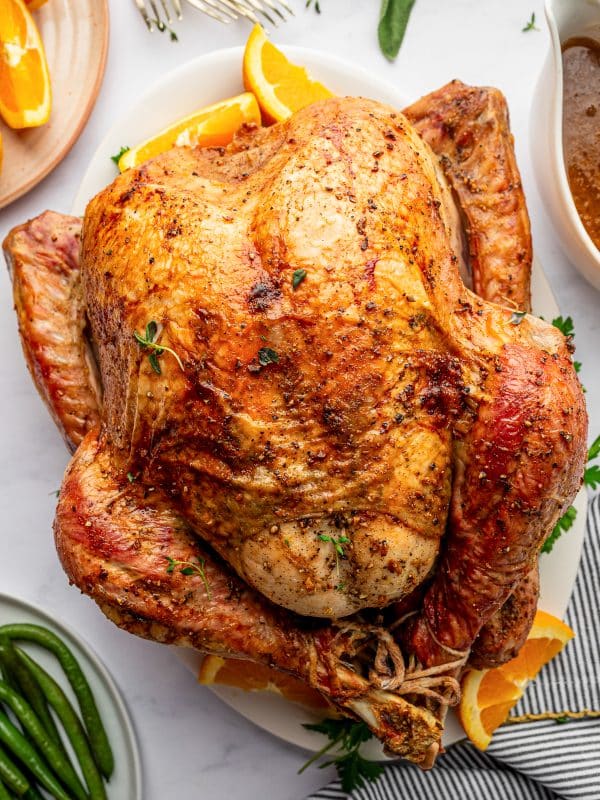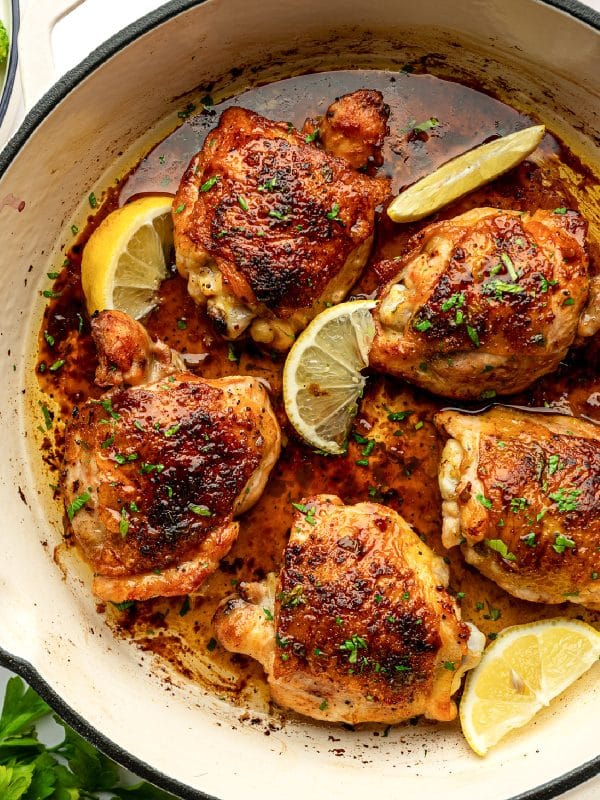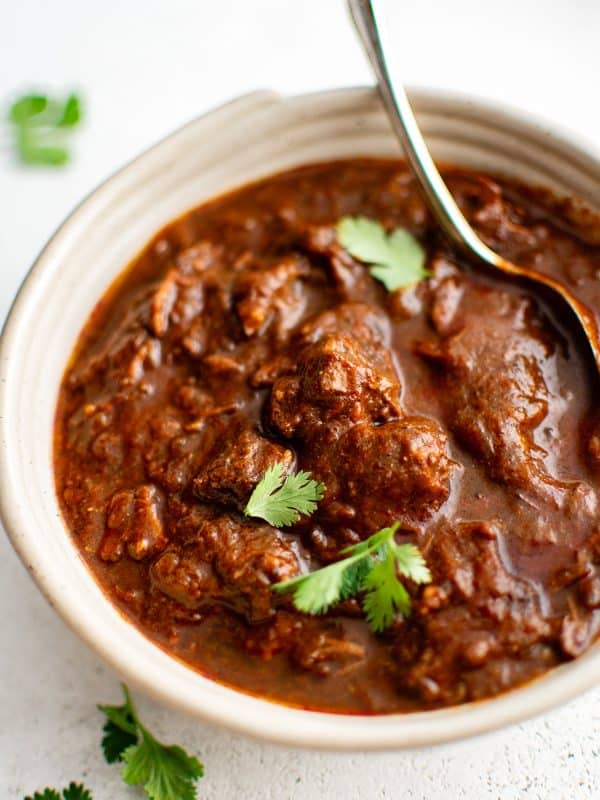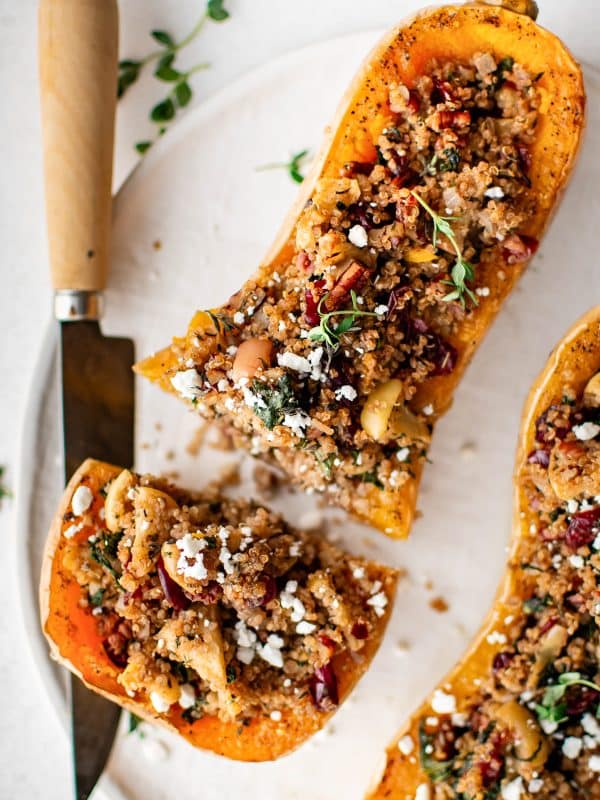This post may contain affiliate links. See my disclosure policy.
Pork Milanese is a classic Italian dish of crispy breaded pork chops pounded thin, coated in breadcrumbs, and pan-fried to golden, delicious perfection. Serve with lemon slices and a light green salad for a simple, flavorful, satisfying dinner.

About This Recipe
Pork Milanese is an upscale version of Shake and Bake Pork Chops (according to me, at least) – refined enough for weekend dinner plans, yet easy enough to make on a busy weeknight. A crispy, cheesy breadcrumb coating is perfectly complemented by a drizzle of fresh lemon juice and a peppery Parmesan Arugula Salad, striking a delightful balance of rich and refreshing flavors. It appeals to kids and adults alike and is ready in under an hour.
- Texture/Flavor: The contrasting crunchy exterior and soft, juicy, meaty interior add to the satisfying combination of rich, savory, and fresh (lemon) flavors.
- Difficulty: It is somewhere between easy and moderate, making it the perfect beginner recipe for anyone new to breading and pan-frying!
- Freezer-Friendly: Yes! You can freeze Pork Milanese before or after frying, making it a convenient make-ahead meal option.
- My #1 Cooking Tip is to use a digital meat thermometer to check for doneness. The pork’s internal temperature should reach at least 145°F (63°C). Insert the thermometer into the thickest part of the cutlet to get an accurate reading.
Table of contents
Ingredients and Substitutions
One of the things I love most about this recipe is that you only need seven ingredients, many of which you probably have already. Listed below are the ingredients you’ll need, plus possible substitutions.
Find the printable recipe with measurements for each ingredient in the recipe card at the bottom of this page.
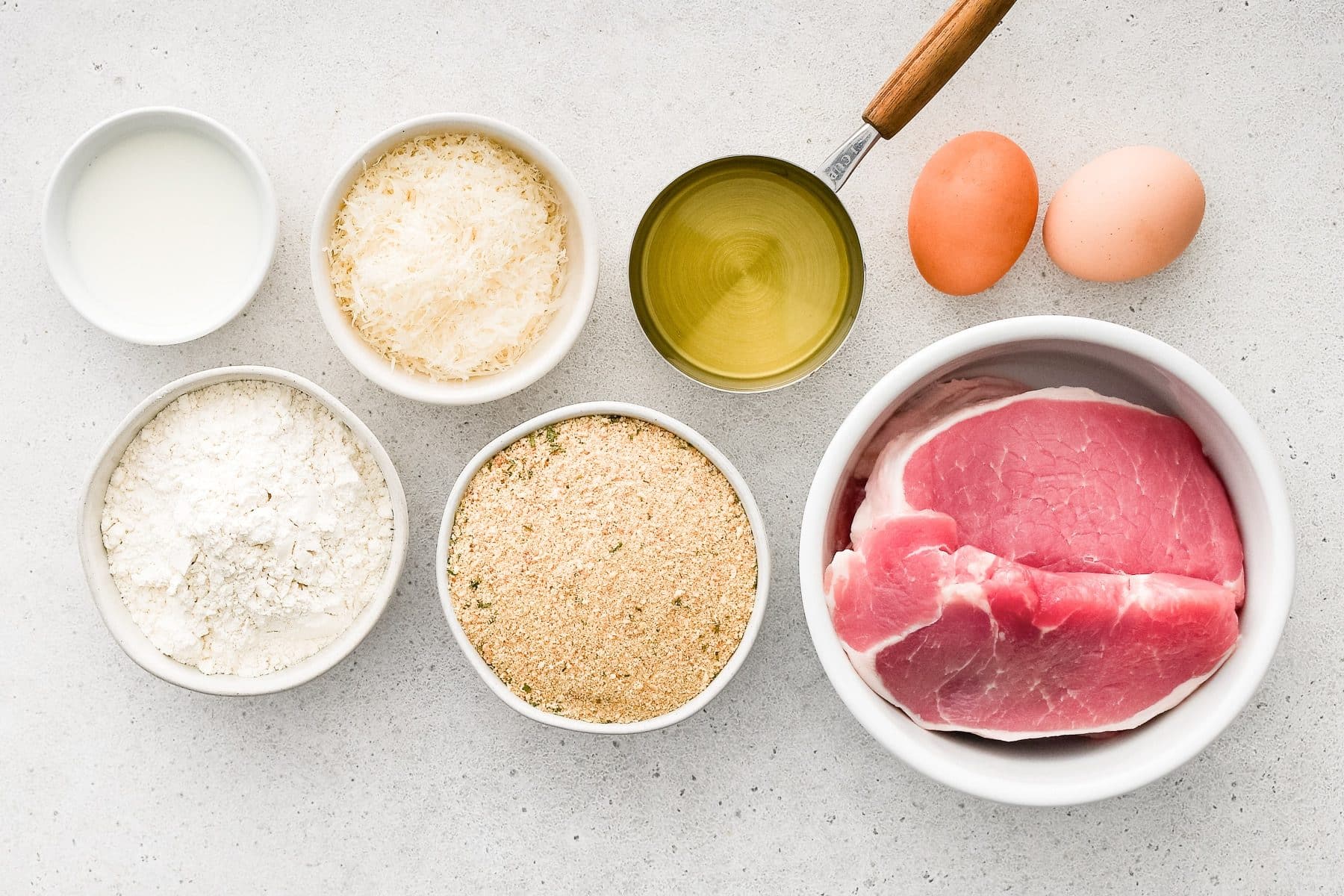
Pork chops: Look for boneless, thin-cut pork loin chops. Tenderloin and bone-in chops may also be used, but boneless chops are the easiest to work with.
All-purpose flour: The flour sticks to the pork to create a dry surface, allowing the breading to stick. Substitute with gluten-free all-purpose flour if necessary.
Eggs + Milk: The egg and milk mixture clings to the flour, creating a wet surface and sticky layer for the breadcrumbs to stick to. Feel free to swap the milk for water or your favorite non-dairy milk substitute.
Breadcrumbs + Parmesan: This recipe uses Italian-style breadcrumbs with grated parmesan. If you have plain breadcrumbs, easily add Italian herb flavor by adding the following:
- 1 teaspoon dried parsley, oregano, and basil
- 1/2 teaspoon garlic powder and onion powder
- 1/4 teaspoon dried thyme, salt, and black pepper
For a crispier breadcrumb coating, try using Panko-style breadcrumbs. Substitute with gluten-free regular breadcrumbs or panko-style breadcrumbs if necessary.
Frying Oil: Vegetable oil, canola oil, peanut oil, and light olive oil can all be used.
How to Make Pork Milanese
1. Prepare the pork: Place each pork chop between two pieces of plastic wrap and pound them using a meat mallet (or rolling pin). Flip the meat over and repeat the process on the other side until they are approximately ¼ inch thick. Pat them dry with paper towels and generously season both sides of the chops with salt and pepper.
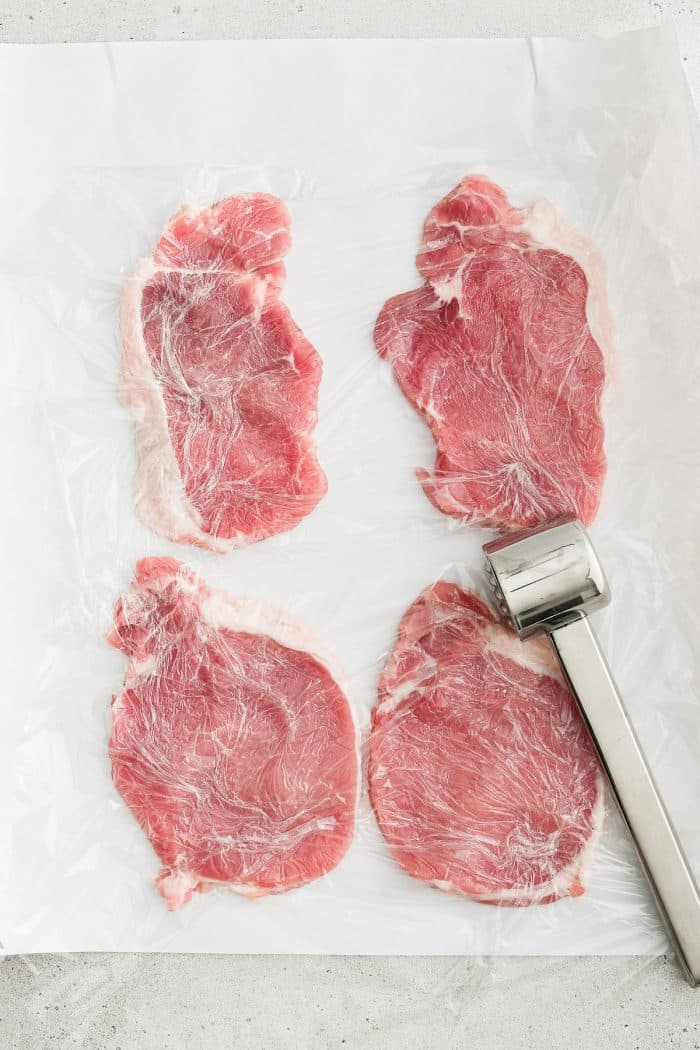
2. Prepare the dredging stations: You’ll need three shallow dishes. In the first, add the flour seasoned with additional salt and pepper. In the second bowl, whisk together the eggs and the milk. In the third, combine the breadcrumbs with the grated parmesan cheese.
3. Bread the pork cutlets: Coat each pork chop in flour, followed by the egg mixture, letting any excess drip off. Finally, coat with the breadcrumb mixture, firmly pressing the breadcrumbs onto the pork, encouraging them to stick.
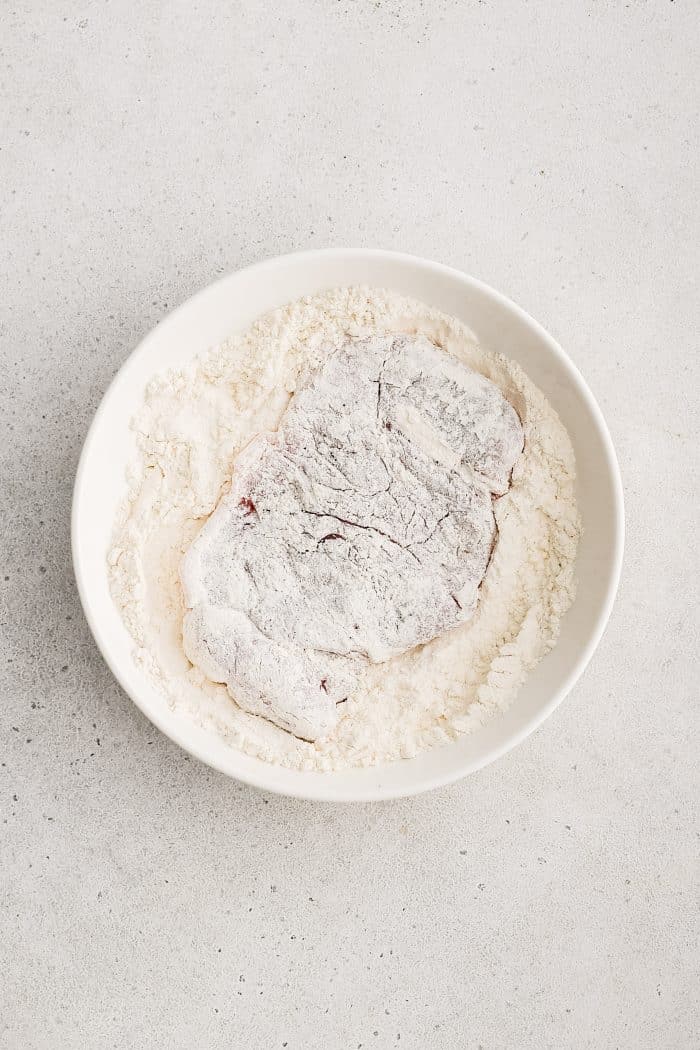
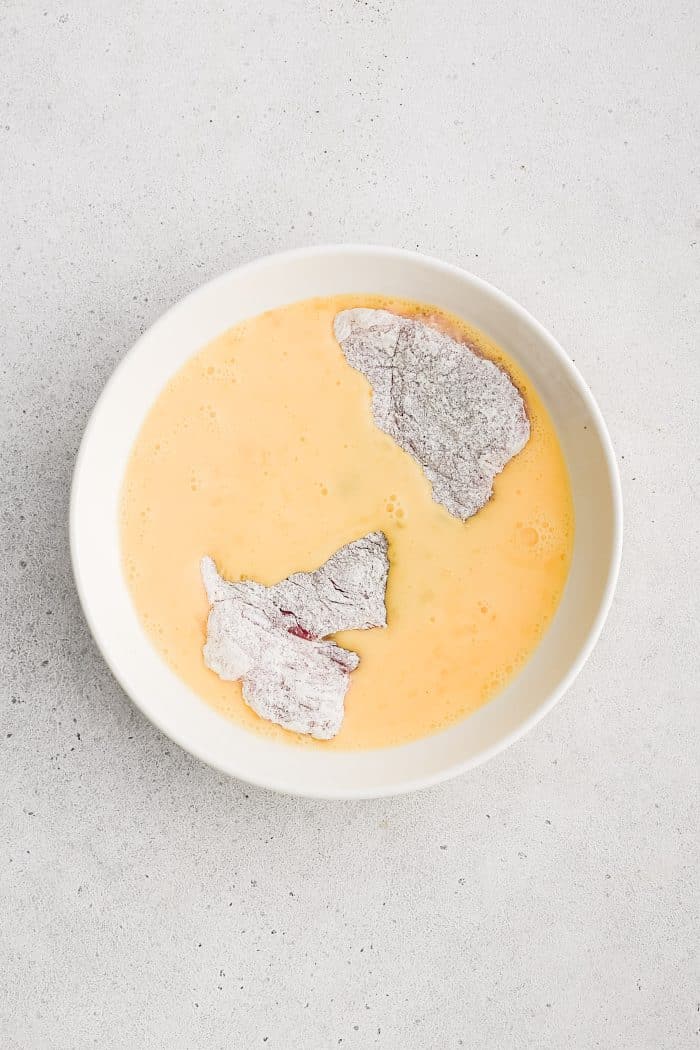

4. Chill (optional but recommended): Place the breaded pork on a wire rack inside a baking sheet and refrigerate (uncovered) for up to one hour.
5. Fry the pork: Heat the oil in a large frying pan set over medium-high heat until it reaches approximately 350°F (175°C). The oil should be about 1/4 to 1/2 inch deep. Add the pork chops to the oil, working in batches to avoid overcrowding the pan. Cook for approximately 5-6 minutes per side or until golden brown and crispy. The pork should reach an internal temperature of 145°F (63°C). Use a digital meat thermometer to check for doneness.


6. Drain the excess oil and repeat: Transfer the cooked pork chops to a wire rack set over a baking sheet or paper towel to drain the excess oil. Allow the oil to reheat before repeating with any remaining pork chops.
7. Serve immediately: Serve hot, garnished with fresh parsley and accompanied by lemon wedges for squeezing over the top.
Recipe Variations
- Air-fryer pork Milanese: Preheat your air fryer to 400°F (200°C) and lightly spray the prepared and breaded pork cutlets with cooking spray. Place them in a single layer in the basket (cook in batches if necessary). Cook for about 8-10 minutes, flipping halfway through, until the breading is crispy and the pork reaches an internal temperature of 145°F (63°C).
- Baked pork Milanese: Preheat your oven to 425°F (220°C) and arrange the breaded pork cutlets on a wire rack set over a baking sheet. Bake for about 15-20 minutes, until the breading is crispy and the pork reaches an internal temperature of 145°F (63°C).
- Chicken Milanese: To make chicken Milanese, swap the pork chops for thinly pounded chicken breasts, following the same method used to make my Parmesan-Crusted Chicken. Cook using your favorite method (frying, baking, or air-frying), adjusting the cooking time accordingly.

Frequently Asked Questions
Pork Milanese is traditionally served with a simple arugula salad and fresh lemon wedges. Mashed Potatoes, rice, Cacio e Pepe, and sautéed vegetables (carrots, zucchini, broccoli, asparagus, etc.) are welcome additions, especially when entertaining company. If you don’t care for arugula, any salad greens will work.
Yes, however, it is best served fresh. To make ahead, prepare the breaded cutlets ahead and refrigerate them until ready to fry, or fry them and reheat them in the oven at 375°F (190°C) for about 10-15 minutes to re-crisp the breading. Option #2 comes with the risk of drying out the pork.
Before you start breading, pat the pork cutlets dry with paper towels. Removing excess moisture helps the flour stick better. Next, use your hands to press the breadcrumb mixture firmly onto the pork cutlets. Then, if you have the time, place the breaded pork cutlets on a wire rack inside a baking sheet and refrigerate (uncovered) for up to one hour. Use enough oil to come halfway up the sides of the cutlets, and make sure it’s hot (350°F) before adding the pork.

Storage and Freezing
Storage: Place leftover cooled pork Milanese in an airtight container in the refrigerator for up to 4 days. If you have multiple pieces, separate them with parchment paper to prevent them from sticking.
Freezing: Allow leftovers to cool before wrapping each cutlet individually in plastic wrap. Place them in a ziplock bag or airtight container and freeze for up to 2 months.
Reheating: To regain as much crunch and texture from the coating, avoid reheating in the microwave and reheat in the oven or air fryer instead.
- Oven: Preheat the oven to 375°F (190°C). Place the cutlets on a wire rack over a baking sheet and bake until warmed through and crispy, usually about 10-15 minutes. If you are reheating from frozen, add additional time until thoroughly reheated.
- Air Fryer: Set the air fryer to 350°F (175°C). Place them in a single layer in the basket and reheat for about 4-6 minutes or until hot and crispy.
To freeze before frying, Arrange the breaded pork cutlets in a single layer on a baking sheet lined with parchment paper. Place the baking sheet in the freezer and let the pork cutlets freeze until solid, about 1-2 hours. This is called flash freezing. Transfer the frozen cutlets to freezer-safe bags or containers. To cook from frozen, do not thaw. Cook them directly from frozen to maintain the best texture and to prevent the breading from becoming soggy.
Looking for more fabulous pork chop recipes to try next? Try my Easy Baked Pork Chops, 15-Minute Garlic Butter Pork Chops, or this Air Fryer Boneless Pork Chops Recipe. Thanks for reading!

Pork Milanese Recipe
Ingredients
- 4 boneless pork loin chops
- salt and pepper, to season
- 1 cup all-purpose flour
- ¼ cup milk
- 2 eggs
- 1 cup Italian-style breadcrumbs
- ½ cup parmesan cheese, freshly grated
- ½-1 cup vegetable oil, canola oil, or light olive oil
- 2 lemons, cut into wedges
- 5 ounces fresh arugula or mixed greens, optional
Instructions
- Place each pork chop between two pieces of plastic wrap and pound them using a meat mallet (or rolling pin). Flip the meat over and repeat the process on the other side until they are approximately ¼ inch thick. Pat them dry with paper towels and generously season both sides of the chops with salt and pepper.
- To prepare the dredging stations, you’ll need three shallow bowls. In the first, add the flour seasoned with additional salt and pepper. In the second bowl, whisk together the eggs and the milk. In the third, combine the breadcrumbs with the grated parmesan cheese.
- Coat each pork chop in flour, followed by the egg mixture, letting any excess dip off. Finally, coat with the breadcrumb mixture, firmly pressing the breadcrumbs onto the pork, encouraging them to stick.
- Place the breaded pork on a wire rack inside a baking sheet and refrigerate (uncovered) for up to one hour.
- Heat the oil in a large frying pan set over medium-high heat until it reaches approximately 350°F (175°C). The oil should be about 1/4 to 1/2 inch deep. Add the pork chops to the oil, working in batches to avoid overcrowding the pan. Cook for approximately 5-6 minutes per side or until golden brown and crispy. The pork should reach an internal temperature of 145°F (63°C). Use a digital meat thermometer to check for doneness.
- Transfer the cooked pork chops to a wire rack set over a baking sheet or paper towel to drain the excess oil. Allow the oil to reheat before repeating with any remaining pork chops.
- Serve hot, garnished with fresh parsley, and accompanied by lemon wedges for squeezing over the top.
Notes
- Cooking time will vary. Use a digital meat thermometer to check for doneness. Pork should reach an internal temperature of 145°F (63°C).
- You can store leftovers in an airtight container in the refrigerator for up to four days. If you have multiple pieces, separate them with parchment paper to prevent them from sticking.
- Let the leftovers cool before wrapping each cutlet individually in plastic wrap. Then, place them in a ziplock bag or airtight container and freeze them for up to 2 months.
- To make this recipe gluten-free, substitute regular flour with gluten-free all-purpose flour and use gluten-free breadcrumbs.
- Pork: Look for boneless, thin-cut pork loin chops. Tenderloin and bone-in chops may also be used, but boneless chops are the easiest to work with. Boneless skinless chicken cutlets or veal may be used instead.
- Milk can be substituted with water or your favorite non-dairy milk substitute.
- This recipe uses Italian-style breadcrumbs with grated parmesan. If you have plain breadcrumbs, easily add Italian herb flavor by adding the following:
- 1 teaspoon dried parsley, oregano, and basil
- 1/2 teaspoon garlic powder and onion powder
- 1/4 teaspoon dried thyme, salt, and black pepper
- For a crispier breadcrumb coating, try using Panko-style breadcrumbs.
- Before you start breading, pat the pork cutlets dry with paper towels. Removing excess moisture helps the flour stick better.
- Use your hands to press the breadcrumb mixture firmly onto the pork cutlets.
- If you have the time, place the breaded pork cutlets on a wire rack inside a baking sheet and refrigerate (uncovered) for up to one hour.
- Use enough oil to come halfway up the sides of the cutlets.
- Make sure the oil is hot (350°F) before adding the pork.
Nutrition
Nutrition information is automatically calculated, so should only be used as an approximation.



